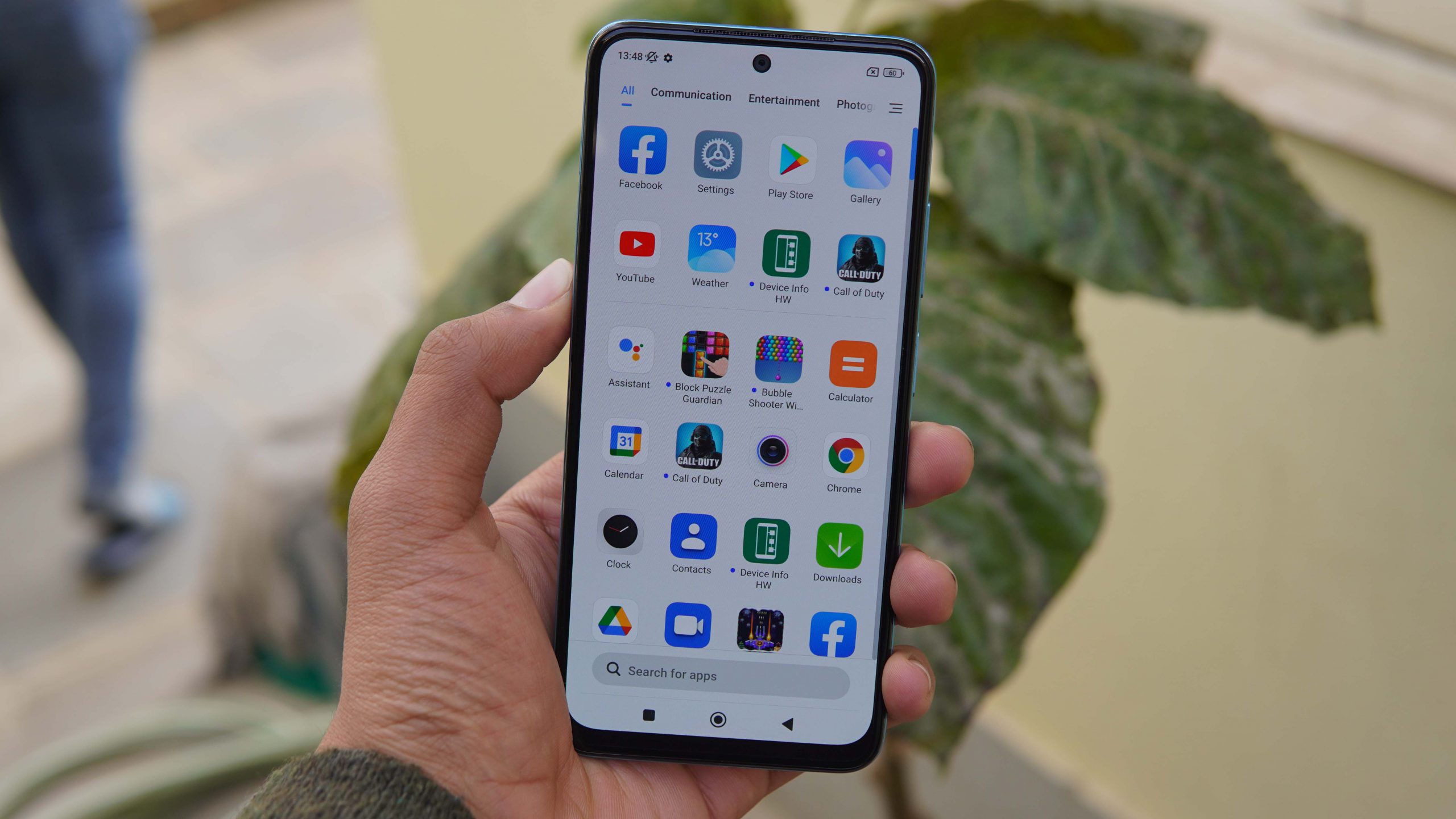Pros
- Good design
- 90Hz AMOLED panel
- Good Battery
- Decent main camera
- Dual speaker
Cons
- Downgraded performance
- Average ultrawide camera
- No 4k video support
Xiaomi has launched the Redmi Note 11 in Nepal. It is an incremental upgrade of the Redmi Note 10.

Redmi Note 11 price in Nepal is Rs. 22,999 (4/64GB), Rs. 24,999 (4/128GB), and Rs. 26,999 (6/128GB).
So, is this a proper upgrade over the Redmi Note 10? Let me answer your question in this full review of the Redmi Note 11.
Redmi Note 11 Specifications
- Body: 159.9 x 73.9 x 8.1 mm, 179g, IP53
- SIM: Dual SIM (Nano-SIM, dual stand-by)
- Display: 6.43 inches AMOLED, 90Hz, 1080 x 2400 pixels, 20:9, 700 nits, 1000 nits (peak)
- Chipset: Qualcomm Snapdragon 680 4G (6nm)
- CPU: Octa-core (4×2.4 GHz Kryo 265 Gold & 4×1.9 GHz Kryo 265 Silver)
- GPU: Adreno 610
- Memory: 64GB 4GB RAM, 128GB 4/6GB RAM, UFS 2.2, expandable via microSD card
- OS: Android 11, MIUI 13
- Rear Camera: 50 MP, f/1.8, 26mm (wide), PDAF
- 8 MP, f/2.2, 118° (ultrawide)
- 2MP, f/2.4 (macro)
- 2MP, f/2.4, (depth)
- Video: 1080p@60fps
- Front Camera: 13MP, f/2.4
- Video: 1080p@30fps
- Battery: Non-removable Li-Po 5000 mAh battery, 33W fast charging
- USB: USB Type-C 2.0, USB On-The-Go
- Misc: Fingerprint (side-mounted), 3.5mm headphone jack, accelerometer, gyro, proximity, compass
- Colors: Graphite Gray, Pearl White, Star Blue
Redmi Note 11 Price in Nepal: Rs. 22,999 (4/64GB) | Rs. 24,999 (4/128GB) | Rs. 26,999 (6/128GB)
Redmi Note 11 Review
Design
- 159.9 x 73.9 x 8.1 mm
- 179g
- IP53
- Dual SIM (Nano-SIM, dual stand-by)

Redmi Note 11 doesn’t steer away from the design of its sibling Redmi Note 10. The overall aesthetics looks similar to the Redmi Note 10 with slight changes.
LATEST: Nokia C30 Review: Big Display & Big Battery Life
The rear panel has a cool finish with glitters spread around the whole panel. Our review unit is a star blue variant that doesn’t seem to catch fingerprints. The Note 11 also retains the IP53 water resistance that we have already seen on the Redmi Note 10.
Xiaomi has made the Note 11 slightly thinner than the Note 10 at 8.09mm but both of them weigh around 179 g.
Overall design aesthetics of the Redmi Note 11 is similar to the Note 10.
For ports and buttons, the volume and fingerprint integrated power buttons are on the right side. On the left, it has a dual sim slot and a dedicated micro sd slot. The bottom of the phone houses a mic, a Type-C port, and a speaker. On the top, it has a headphone jack, a second speaker, and an IR blaster.
Display
- 6.43 inches AMOLED
- 90Hz
- 1080 x 2400 pixels
- 20:9
- 700 nits

Redmi Note 11 gets an upgrade in terms of display with a 6.43 inches 90Hz AMOLED panel with a screen resolution of 1080 X 2400 pixels.
The color reproduction is good which is what we expect from an AMOLED panel. On top of that, the added 90Hz smoothness makes this a good upgrade over the Redmi Note 10’s 60Hz AMOLED panel.
The 90Hz refresh rate is optimized and I didn’t face any ghosting issues. You can either set the display to 90Hz or 60Hz but the refresh rate will drop to 60Hz if the screen is idle even when the display is set to 90Hz.
Camera
- Rear Camera: 50 MP, f/1.8, 26mm (wide), PDAF
- 8 MP, f/2.2, 118° (ultrawide)
- 2MP, f/2.4 (macro)
- 2MP, f/2.4, (depth)
- Video: 1080p@30fps
- Front Camera: 13MP, f/2.4

Note 11 gets a 50MP Samsung JN1 main sensor which is a minimal upgrade over the 48MP main sensor of the Redmi Note 10. Except that, it gets the same 8MP Ultrawide sensor, 2MP Macro sensor, and a 2MP depth sensor.
NORMAL PHOTOS
The new 50MP sensor can pump out good photos in daylight conditions with a decent amount of detail. However, the photos lack a bit of sharpness. The photos come out vibrant with the right amount of saturation but the exposure was a hit or miss.
In some photos, the darker area was not exposed properly and the photos look underexposed. One of the main reasons behind this issue was the Auto HDR. The Auto HDR would not trigger HDR which resulted in sub-optimal results. So, I turned on the HDR option manually which resulted in better photos but the HDR was a bit too aggressive.
The main sensor still needs to be fine-tuned to get optimal results.
ULTRAWIDE PHOTOS
The ultrawide photos have a slightly toned-down color compared to the main sensor. In fact, they look soft and lack proper detail.
The 8MP ultrawide sensor of the Note 11 is only decent.
LOW LIGHT PHOTOS
The Samsung JN1 50MP sensor tries to keep the noise levels as low as it can in low light conditions. However, this results in underexposed photos and it is more evident in photos without a light source.
The night mode preserves details and the light source is well exposed. But the photos without a light source do not get much improvement.
FRONT CAMERA
I like the face tone of the selfies and the exposure also looks good. The color is also vibrant but some photos might look a bit underexposed.
In the case of portrait selfies, the background blur is decent and the edge detection is average. Overall, the selfie camera on the Redmi Note 11 is good.
VIDEOS
Unlike the Redmi Note 10, the rear camera of the Note 11 doesn’t support 4K video recording. It is capped at 1080p 60fps. However, this limitation is due to the Spectra 346 ISP used on the Snapdragon 680 chipset.
Talking about the video quality, the 1080p videos do not have good detail and lacks sharpness. The pan smoothness is also only average. The 1080p 60 videos look smoother but it sacrifices details. As for the stabilization, the videos do not have good stabilization and there are no stabilization options in the settings menu.
Performance
- Qualcomm Snapdragon 680 4G (6nm)
- Octa-core (4×2.4 GHz Kryo 265 Gold & 4×1.9 GHz Kryo 265 Silver)
- Adreno 610
- 128GB 6GB RAM
Redmi Note 11 is using the all-new Snapdragon 680 4G chipset. It features an Octa-core CPU with 4X Cortex-A73 cores and 4X Cortex-A53 cores.
The new chipset may look like a direct upgrade over the older Snapdragon 678 chipset used on the Redmi Note 10 but that’s not true. Snapdragon 678 uses 2X Cortex-A76 cores and 6X Cortex-A55 cores which provides better CPU performance. Along with that, it also has an Adreno 612 GPU which is better than the Adreno 610 GPU of the Snapdragon 680 chipset.
With that out of the way, the Redmi Note 11 still feels smooth in normal usage. The device sails through normal tasks like opening apps, app switching, and multi-tasking.
GAMING
In terms of gaming, Redmi Note 11 cannot play games at higher graphic and fps settings like the Redmi Note 10. We tested FreeFire, PUBG Mobile, and COD Mobile on the Redmi Note 11.

FreeFire can be played up to Ultra graphic with High Res turned to High. In this setting, FreeFire was ultra-smooth with 0% lag and zero fps drops. You can see in the chart above that the average fps was 59.7 and the fps is maintained through the whole session.

Moving on to PUBG Mobile, you can play it up to Balanced graphics and Medium fps setting. You will need to play at Smooth graphics for the High fps setting. In Smooth settings, we were able to get average fps of 29.8 fps without fps drops and stutters.

At last, you can play COD Mobile up to Very High graphics with Medium fps setting. If you want to plat at the High fps setting, you will need to dial down the graphics to Low. At Very High settings, the gameplay was smooth with almost zero stutters but we did notice occasional frame drops. Likewise, we were able to achieve an average of 55.7 fps and an average temperature of 48.5°C in the first 15 mins of the gameplay. After 45 mins, the average fps was hovering around 56 fps and the temperature was around 50.5°C.
Overall, the Redmi Note 11 does not provide you with max graphics and max fps settings. But, it can play games at low-medium settings without any issues.
Battery
- Non-removable Li-Po 5000mAh battery
- 33W fast charging
Redmi Note 11 has a 5000mAh battery and comes with a 33W fast charger.
The battery capacity and the charging capacity remain the same as the Redmi Note 10. However, the Snapdragon 680 is a 6nm chipset which is much more efficient than the Snapdragon 678.
Redmi Note 11 provides around 8 hours of screen on time even with an hour of gaming. And, it can easily last for more than a day under moderate usage.
Biometrics and Speaker
- Side-mounted fingerprint sensor
- Dual stereo speaker
The fingerprint sensor on the Redmi Note 11 is integrated into the power button. The fingerprint sensor is fast and consistent.
Talking about the speaker, there are two dedicated speakers on the Redmi Note 11. Overall, it is loud and the clarity is also good but it lacks bass.
Software
- Android 11
- MIUI 13

I was expecting Redmi Note 11 to come with Android 12 out of the box but sadly it doesn’t. It uses MIUI 13 on top of Android 11.
We get the same MIUI experience with a split notification control panel. Xiaomi also claims that MIUI 13 offers better app fluency with 15% fewer dropped frames in third-party applications. Xiaomi’s native apps also run better on the new release, with 23% fewer dropped frames.
In this variant, we also get an option for extended 2GB RAM. Likewise, there are some bloatwares like TikTok, State of Survival, Tile Fun, and more.
Should You Buy Redmi Note 11?
Redmi Note 11 is no doubt a good device but it isn’t necessarily an upgrade over the Redmi Note 10.
If you want a smoother 90Hz screen and better battery life then you can go with the Redmi Note 11. However, if you want better gaming performance and 4K video support then you should look at the Redmi Note 10.
Also, I’m not convinced with the new main camera sensor. The IMX582 sensor of the Redmi Note 10 was much more optimized than the new sensor of the Note 11.
If you want my advice, wait for the Redmi Note 11 Pro.
READ NEXT: Vivo V23e Review: Good Selfies at a Premium Price
What do you think about the Redmi Note 11? If you have any questions, let me know in the comments!
Also, watch our review video of the Nokia C30 in Nepali.
-
Zeblaze Stratos 2 Plus with Built-in GPS Launching in Nepal on New Year’s DayHIGHLIGHTS The Zeblaze Stratos 2 Plus price in Nepal is Rs. 9,000 (offer price is…
-
9th Edition of the Indrive ICT Award Successfully Organised; 22 Entities Bag AwardsHIGHLIGHTS Living with ICT successfully organised the 9th Edition of the Indrive ICT Award 2024.…
-
BYD M6, A Premium MPV, Officially Launched in Nepal at Rs. 58.90 LakhsHIGHLIGHTS BYD M6 price in Nepal is Rs. 58.90 Lakhs. It is powered by a…





























